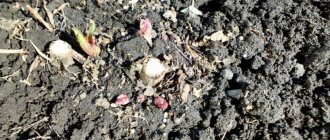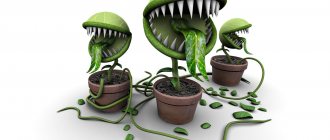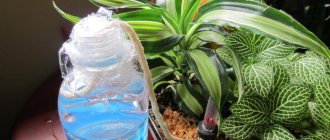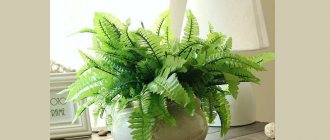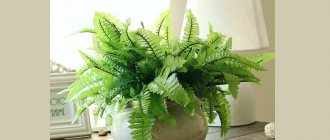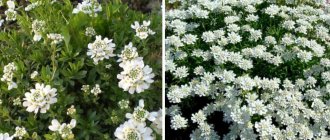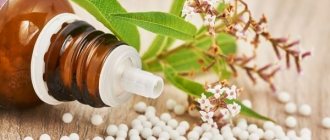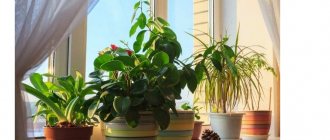Advanced summer residents, before developing a new site, begin to determine the chemical composition of the soil. This is done very correctly! After all, there are often situations when, despite carrying out all the necessary activities and lovingly caring for the beds, it is not possible to obtain the desired result when growing a certain crop. Of course, it’s easier to blame weather conditions, the wrong variety, diseases or lack of nutrients. Not everyone will think that perhaps the acidity of the soil, which is not suitable for your crops, is to blame.
Description of acidic soils 2. What conditions does pH depend on 3. Types of soils 4. Plants for acidic soils 4.1. Plants in the garden 4.2. Which indoor plants love acidic soil 5. Ways to increase acidity
Photo: Oddly enough, many plants prefer acidity.
Characteristics of acidic soils
pH - these letters are found in recommendations for the cultivation of almost any crop or variety. What is this designation and why do you need to know it? They indicate the acidity of the soil - a very important indicator for any vegetation. Let's figure out how it affects the growth and development of all crops, and establish an attitude towards the acidity of various home or garden plantings.
Soil acidity is the state of the soil when it acquires the properties of various acids. It depends on the presence of hydrogen ions in it. An important role here is also played by the content of aluminum, which oxidizes it. Experimental studies have established that there are much more acidic soils in the vast territory of our country than alkaline ones. This is especially true for our middle zone.
Why is it important to know acidity levels? The fact is that a huge number of chemical and biochemical processes in our environment, including soil, depend on acidity values.
| Important. This soil characteristic is of great, often paramount, importance for the normal development of cultivated plants. |
In order to grow full-fledged healthy plants and always have good harvests, it is imperative to monitor acidity levels, since the ability of green plants to absorb nutrient ions from the soil solution depends on it.
Such soils have an inhibitory (depressing) effect on the growth of the root system, thereby slowing down its absorption capacity. As a result, the supply of phosphorus, magnesium, potassium, calcium - the main vital elements - to plant organisms is significantly reduced, and, as a result, plants do not receive the necessary nutrition. On alkaline soils, it is difficult to supply plants with microelements: magnesium, zinc and boron. Soil microorganisms, so necessary for structurization, work only in an environment with slightly acidic characteristics.
Photo: Acidity levels need to be monitored.
The most favorable conditions for the required plant nutrition are considered to be soils with neutral indicators or not far from them. In other conditions, there is an excess absorption of some nutrients and a deficiency of others. As a result, there is a deficiency of certain elements that negatively affect the development of plants, the formation of the crop and its quality.
This is only a small part of the usefulness of pH knowledge. They will help you start developing the site in a timely manner and correctly distribute your efforts and funds for the purchase and application of fertilizers, the need for liming, and the correct selection of garden or garden crops.
LiveInternetLiveInternet
Quote from Nina_Rudakova's message
Read in full In your quotation book or community!
15 ornamental plants for acidic soils
https://www.7dach.ru/SilVA/15-rasteniy-dlya-kislyh-pochv-6605.html#ixzz3zEEE2Ext
What to do if you have acidic soil on your site? After all, a significant part of ornamental and fruit and vegetable crops prefer a neutral or slightly alkaline environment. I suggest not to be upset and plant the area with plants that thrive in acidic soil. We will talk about them.
What is acidic soil?
First, let's figure out which soils are called acidic. When assessing soil acidity, a scale from 1 to 14 pH is used. You can determine acidity using indicator strips, which are sold in garden centers and stores.
An experienced gardener can determine the acidity of the soil even by indicator . For example, horsetail, sorrel, a whole range of mosses, conifers (spruce, Scots pine), heathers, rowan, aspen, and viburnum prefer this type of soil. In fact, in vast areas of non-chernozem regions, soils with high acidity are common. They are rich in free hydrogen and aluminum ions. You can read more about soil types and how to change them in this article. In the meantime, I suggest you get acquainted with the beautiful plants growing in acidic areas.
1. Azalea, or rhododendron
Azalea (Azalea) is part of the rhododendron genus; this is usually the name given to beautifully flowering rhododendrons of various species (Indian azalea - Rhododendron simsii, Japanese azalea - Rhododendron obtusum). This is a deciduous or evergreen shrub belonging to the heather family (rarely small trees), it is very decorative, but quite thermophilic. It begins to bloom in early summer and simply requires acidity in the soil for good development. Medium acidity is best. Provide this plant with coolness, light shade, drained but well-moistened soil, and lush flowering will not take long.
In the middle zone there may be difficulties associated with wintering. Therefore, pay attention to zoned varieties and choose places for rhododendron wisely - protected from winds and direct sunlight. Preferably on slopes where the sun is only in the first half of the day, or near not very tall spruce and pine trees. Heavy, clayey, ever-wet soils should be avoided. 2. Acrid buttercup
The caustic buttercup (Ranúnculus ácris) lives in highly acidic soils. This is a poisonous plant. It is not suitable for bouquets, since its juice can cause nausea and irritation of the mucous membranes, but it looks great in a flowerbed, especially the double form with large flowers (for example, the Flore Pleno variety).
3. Heather
Heather (Calluna vulgaris) is a small shrub or shrub. All year round, colorful heather gives a festive mood and a well-groomed appearance to the place where it grows. The plant loves bright sun and good moisture. It grows on acidic soils, so it is often found in nature near peat bogs and swamps. Planting heather in different regions of our country (especially southern Russia) can be fraught with some difficulties. Common heather flowers can be white, pink, red or purple. Currently, it has a huge number of unusual varieties and varieties, for example, the varieties Callun and Eric are very decorative.
4. Swamp viola
Swamp viola (Viola palustris) not only grows on acidic soil, but moreover, it cannot exist on soil of normal acidity!
And species such as tricolor violet or dog violet are lovers of medium acidic soil reaction.
From my own experience of growing violets, I can say that in unsuitable soil the flowers become very small and then completely degenerate. You can learn about how to properly cultivate the plant, as well as about its various varieties, from the articles Such cute violets, Viola is the favorite granddaughter of the violet, The pubescent violet blooms in November!. 5. Moss
Moss (division Bryophyta) is the main lover of acidic soil. I love this fluffy velvety green rug. Many hobbyists plant a whole garden of different mosses. Several years ago, a good landscape design specialist advised me to carefully transplant the moss that had grown between the tiles along the path near the spruce tree or near the apple trees to the right place. Moss from the roof of grandma's old shed in the village is also perfect. It is better not to use forest moss on the site.
There are many articles and notes on the site about how to use moss in the landscape design of your site: Living and nonliving, Magic Garden, Guests from the Forest!, Sketches. Spring inspiration, Clearing for the forest fairy. Just imagine how many unusual things you can create on acidic soil, using such seemingly ordinary moss! 6. Kalina
Viburnum (Viburnum) is a small deciduous shrub and sometimes a small tree. You can get to know her in more detail in Kalina’s article of the same name. For this plant, slightly acidic soil will be optimal; too acidic soil will not work. This plant is a godsend due to its decorative value in the spring, when the bush is strewn with umbrella-shaped inflorescences (Viburnum gordovina - you, darling, look good in all your outfits). And in the fall it has no equal at all. Bright red berries are like beads among colorful autumn foliage (Viburnum red). Almost all types of plants - forked viburnum, gourdovina viburnum, toothed viburnum, Canadian viburnum, common viburnum - develop well in slightly acidic soil. In addition, viburnum is an unusually useful plant that will help prevent some health problems or solve them using traditional methods (Red viburnum can help!, When and how to collect medicinal plants correctly). 7. Hydrangea
Hydrangea (Hydrangea) petiolate, paniculate, ash or gray, tree-like, Bretschneider and many other species grow well in slightly acidic soils, and large-leaved hydrangea feels great already at 4 pH. These are spreading dense shrubs or small trees. Their inflorescences attract everyone's attention. It is not difficult to care for it; more about this in the article Hydrangea: planting and care.
I have slightly acidic soils. Tree hydrangeas are planted almost throughout the entire area. Large snow-white inflorescences and strongly growing bushes look very beautiful along the fence. And how many unusual things can be created using these plants, the article will tell you about the Hydrangea Garden in the Aivazovskoye health and recreation center. 8. Lupine multileaf
When the construction of our “nest” was just beginning, there was a field all around, completely dotted with multi-colored lupins. There were pink, purple, and white flowers here. In addition to doing well in slightly acidic soil, lupins (Lupinus polyphyllus) also make excellent green manures that improve soil quality. This is facilitated by special bacteria that store nitrogen and live in nodules that form on the roots of the plant. With good development, lupine bushes are strong, with a height of 50 cm. You can find out more about the cultivation of this plant here. 9. Fothergilla Gardena
A very unusual shrub that can grow in acidic soils. It grows very slowly; when propagated by seed, it will bloom only after 10 years. Large Fothergilla also grows well in acidic soils. I like its fluffy beautiful white flowers. It has several bright varieties, for example, the Blue Shadow variety has foliage of an unusual silver-blue color, and in the fall the leaves are orange-red purple. 10. May lily of the valley
Lilies of the valley (Convallaria majalis) have long become a symbol of spring and tenderness. Having brought a lily of the valley to my house once, I never regretted it. They are perfectly adapted to soils of medium acidity, but prefer slightly acidic soil. The bright greenery, complemented by lovely little white bells, will fit very well into any garden. It should be remembered that the fruits of this plant are poisonous, and remove the purple balls in time. I combine lilies of the valley with moss, spruce, as well as tree hydrangea and hosta. You can find out how to grow these delicate flowers and when is the best time to do it here. 11. Badan
Bergenia is a lover of the most acidic soils. Increasingly, this beautiful and medicinal plant adorns stone gardens, hills and the area around the pond. . The flowering period of bergenia occurs in spring. It has extraordinary thick leaves, from a distance reminiscent of burdock leaves. And the inflorescences of bright crimson color attract attention. In floriculture, thick-leaved or Mongolian bergenia (pink and crimson inflorescences) and heart-leaved bergenia (pink inflorescences) are very common. I often see on packets of seeds that slightly acidic soil is preferable for bergenia, but this is even an understatement. And to get to know it better, learn everything about its planting and subsequent care, I suggest reading the article Badan - a unique healer. 12. Creeping tenacious
Creeping creeper (Ajuga reptans) is a fast-growing ground cover. Begins to bloom in late spring. Pyramid-shaped inflorescences of purple, pink, white flowers. Prefers slightly acidic soil. This plant of forests and steppes smoothly migrated to our areas. Many people like its early flowering, and others choose it as a good ground cover. He also has his fans among fans of “gardening on the terrace.” And such a useful decoration will always find a place in a rock garden.
Be that as it may, demand creates supply, and now the survivor has many beautiful varieties. If there is a need to use it as a medicinal plant, read the article Autumn transformation of the creeping tenacious plant.
Personally, I really like the Pink Elf variety - the bushes are very compact, and the flowers range from light pink to dark pink.
13. Asian lily hybrids
Asiatic lilies tolerate slightly acidic soils. Complex hybrids have direct roots of East Asian origin. This is a very large group where hybrids and garden forms originate from the following types of lilies: tiger, lanceolate, calloused, drooping, dwarf, single-colored, David, Ward, single-colored and interspecific hybrids of Dutch and spotted lilies. They reproduce very simply: by bulbs, even by scales.
It is advisable to choose sunny areas for these plants, but they can also develop well in shade. You can see all kinds of lily hybrids with your own eyes by looking at the articles of our gardeners: Lilies. Sad story, Eastern beauty, The lilies have bloomed, Lily is the virgin queen of the garden. 14. Flowering calicanthus (spicy bush)
A distinct spicy aroma is emitted by all parts of the plant. A beautiful crown of strong, densely located branches. It blooms in May, the flowers are large, pastel red. Can grow in both shade and sun. Quite thermophilic.
15. Prickly polygon
A beautiful fern about 80 cm high. It can grow both in the shade and in open sunny areas, but an important condition for its growth is high soil and environmental humidity.
Of course, the choice is not limited to the plants listed, and although their variety is not so great, you can also come up with successful “arrangements” from them that will delight you for many years. In addition, today there are plants specially bred for acidic soils. I especially envy the residents of the southern regions, where camellia can be cultivated. This is a very common plant on the Black Sea coast. I first saw camellia in Sochi in the botanical garden, its alluring aroma and beautiful flowers struck me to the core. But she also prefers soils with high acidity. When you can’t, but really want to
It happens that some plant gets into your soul and you begin to think about how to plant it in your home if the conditions are unsuitable? For example, how to grow a plant that likes alkaline soils if yours is acidic? Don’t be upset; you can try to “quench” the acid reaction by adding lime, dolomite flour or ash. Below I have provided a table for different types of soil with different PH reactions, from which you can find out how much lime you need to add to reduce the acidity of the soil. I often use dolomite flour or wood ash to improve the quality of my soil. Please note that changes do not occur immediately, but over 2-3 years. Therefore, you should not apply the “additive” too often. And once again I recommend you the article “How to find out the type of soil and why you need it.”
What affects acidity
What conditions does pH depend on? Or, more correctly, what influences this indicator to a greater extent? First of all, the climate in a given area, the proximity of peat bogs or forest areas, the lack or excess of water resources, as well as the care of this area and proper agricultural technology.
Let's consider what digital indicators indicate the level of acidity.
- The most significant number in this matter is 7 (more precisely 6.5–7.4), indicating a neutral character. All indicators below this figure, up to a value of 4.5, indicate an acidic character (from a slightly to strongly acidic reaction of the soil solution).
Photo: Each culture has its own requirements.
- Values in the range of 7.5–8.5 indicate alkaline types. Consequently, the farther the digital values in your soil analyzes are from the average values (7), the stronger the reaction of the soil solution towards the extreme boundaries, i.e. very acidic or very alkaline.
- When starting gardening, it is important to know that each type of plant has its own special requirements for the reaction of the soil environment. All garden plants can be divided into three groups according to their pH requirements: acidophiles (pH 5.0–6.4), neutrophils (pH 6.5–7.4), basiphiles (pH 7.5–8.5).
Vegetable garden on acidic soils. What vegetables grow on what soils.
Vegetable garden on acidic soils
Deoxidize the soil with fluff lime, chalk, limestone, quicklime or bone meal. Ash will also do. It is best to take fluff lime for these purposes.
There is no need to contribute it frequently. If chemical analysis has been done, then the required dose must be applied once every 6-8 years.
In acidic soils, you also need to be careful when applying fertilizers. Many mineral fertilizers shift the reaction of the soil solution to the acidic side. Therefore, it is necessary to mix lime into them in problem areas. Lime is added per 1 kg of fertilizers: for ammonium sulfate - 1.3 kg; for ammonium nitrate – 0.7 kg; for superphosphate – 0.1 kg; for potassium chloride – 0.5 kg.
Is it good when the soil on the site is acidic or not? Good for some crops. These are blueberries, honeysuckle, cranberries and other relatives from the heather family.
Although there are crops that like to be acidic, it is not advisable to plant them after liming. These are sorrel, potatoes, chicory. By the way, potatoes after liming can be severely affected by scab.
They prefer moderate sourness in turnips, radishes, carrots, tomatoes, and pumpkins.
The following can grow on acidic soils:
serviceberry, mountain ash, horseradish, sorrel, leopard, rhododendron.
There are times when the soil is very acidic and plants develop poorly because of this. Then you urgently need to water them with a solution of lime, diluting 60-100 g of chalk or fluff lime in 10 liters of water. By watering the beds with such water, the result can be seen within two weeks - the plants quickly come to life and begin to grow well.
Ash is also applied superficially - when watering, it quickly penetrates the soil and alkalizes it.
But immediately after liming, it is useful to sow and plant almost all varieties of cabbage, beets, peppers, onions, parsnips, scorzonera, celery, and asparagus.
In the second year after adding lime, the following grow well: beans, peas, beans, eggplants, kale, cucumber, head lettuce, rutabaga, onions, spinach, zucchini, luffa, lagenaria, melon.
What plants are grown in soils of different acidity?
A roughly established classification of the main agricultural and indoor crops depending on the requirements for the reaction of the soil solution will make your search easier:
- On neutral or slightly alkaline (pH 7.0–8.0) soils, asparagus, onions, celery, cabbage plants (cauliflower), mustard, parsley, as well as raspberries, peonies, and delphinium thrive.
- On neutral and slightly acidic soils (pH 6.0–7.4), almost all vegetables will bear fruit with gratitude: carrots, radishes, cucumbers with other pumpkins, legumes (peas, beans), spinach, beets, lettuce, garlic and the main part nightshades (tomatoes, eggplants, bell peppers). In addition, currants, red currants, sea buckthorn, gooseberries and most stone fruits love such areas. They are favorable for the bulk of garden flowers.
- Pome fruits, black currants, honeysuckle, strawberries, potatoes, lilies, and phlox grow well on slightly acidic soils (pH 5.5–6.0).
- Corn, raspberries, blackberries, watermelons, melons, and radishes are placed on medium-acid ones.
Photo: Black currant prefers slightly acidic soils.
It should be borne in mind that there are often plants that perfectly tolerate various environmental conditions, adapting and changing their properties. An example of this is the large-leaved hydrangea flower. By the color of the flowers, you can understand what level of acidity she has chosen: in an acidic environment, the color of the flowers is blue, in an alkaline environment - pink, in a neutral environment - white-beige. Therefore, it is easy to control the color of the flowers you like.
| Reference. Acidity tolerance may change as plants age. Young plants are most sensitive to this indicator. An acidic environment has the most powerful effect on plant organisms at the beginning of the growing season. Please note that for many garden crops, failure to comply with the necessary conditions for the level of soil acidity can be disastrous. |
However, acidic soil is not always a problem. The list of plants that love acidic soil is quite extensive. Consequently, from such plants it will be possible to easily create completely decorative areas, forming a unique landscape. Soils with pH values in the range of 5.5–6.5 are most preferable for these crops.
What to plant in a sour garden
A little later we will tell you how to deoxidize the soil if necessary. In the meantime, let’s list the plants that will love your garden just the way it is.
garden plants
If the garden is filled with slightly acidic soil or soil with an average level of acidity, feel free to plant berry crops such as raspberries, blackberries and currant bushes on its territory. A similar soil is quite suitable for ordinary gooseberries. The popular strawberry, which in scientific sources is called garden strawberry, is no exception. All these plants will happily develop and bear fruit in a “sour” garden.
If you want to plant wild berries, you will either have to increase the acidity manually or choose a location with highly acidic soil for it. The optimal pH value for wild lingonberries and tasty blueberries, as well as blueberries and healthy cranberries, ranges between 4.0 and 4.5.
Blueberries are the only shrub among wild berries that will tolerate only very acidic soil. Medium and slightly acidic soil is not suitable for growing this crop.
Blooming crops
Flowers are the group of plants that have more acid lovers than any other. Below we list the most basic ones.
- Rose. If you want to grow a stunning and fragrant rose bush, provide the queen of flowers with highly acidic soil.
- Peony. If you see that a handsome peony has grown one and a half meters in height, it means that he likes its location. And if the peony likes the place in which it grows, then this place has acidic soil.
- Fern. Shade and acidic soil are two conditions for the active growth of one of the oldest ornamental plants for the garden - the popular fern.
- Hydrangea. This is generally an amazing plant that is suitable not only for acidic, but also for alkaline soil. By the way, by the flowering of hydrangea, you can roughly determine the soil pH. The bush blooms pink in the presence of acid, and blue in the presence of alkalis.
Among those who should also be named among the admirers of sour earth are beautiful magnolias, bright poppies, modest forget-me-nots and baby purslane.
Vegetables
If it is not so difficult to find admirers of “sourness” among flowers and garden crops, then among vegetables there are practically none. With a few exceptions. And such an exception is the pumpkin crop and the main representative of the Solanaceae - the irreplaceable potato. If you provide quality care to your carrot crop and tomato bushes, they will also be able to give you a good harvest on acidic soil. The same goes for greens, which survive well in conditions of abundant acid.
Potatoes that grow in acidic soil may experience serious problems. her name is wireworm. The larvae of this potato eater are also lovers of acidic soil, so they often destroy the potato harvest in an “acidic” garden.
What plants like acidic soil: list
Let's look at a situation where you have a plot with acidic soil, and there is no possibility, and sometimes no desire, to correct this situation in the near future. Don't be upset. There is always a way out! It turns out that there are a significant number of plants that love it. Here are some of them.
Photo: Garden azalea also loves “sourness”.
What plants like acidic soil in the garden?
Such acidophilic plants, also called acidophytes, include almost all conifers, forest berries (blueberries, lingonberries, as well as medicinal blueberries and cranberries), azaleas, wild rosemary and many other representatives of the plant world.
Ferns
Plants that inhabit acidic areas everywhere. Their most common representative is the decorative multi-row spiny plant, which has an attractive spreading bush.
Shrubs
Rhododendrons are widespread across our vast territory - tall, up to two meters, shrubs that are pleasing to the eye from April to July, as well as their late varieties such as rhododendron Veresk, low, no more than half a meter in height, growing until the month of October. Most of their representatives are winter-hardy, but there are specimens that require special shelters in harsh climates.
Flowers
Everyone's favorite peonies prefer acidic soils, with very low pH values. In such beds, the flower grows well up to 1.5 m, bushes and pleases us with lush color. Perhaps for this reason it is not possible to grow your favorite flower in your area.
Photo: The more acidic the soil, the better for lupine.
Lupine simply loves such soils. Moreover, the more sour, the better. In such conditions, it can grow up to a meter or even higher, and is also an excellent green manure.
Forget-me-nots and lilies of the valley also grow well in such places. Lilies can also be placed in acidic areas. True, not all, but only Asian hybrids.
It may come as a surprise to some that the queen of flowers, the rose, simply loves sour areas. Try to please the rose bushes, add special acidifiers to the soil. However, there are some varieties with other soil preferences. Therefore, be careful. Read the characteristics of the variety before purchasing in a store or nursery.
Photo: And roses like this soil!
Poppies, purslanes, various carnations, which grow quickly in June-August, being an excellent honey plant, attract pollinating insects. It does not react at all to the high acidity of zinium, regardless of the wide variety of its types.
Trees
You can plant coniferous trees of any kind, creating a wonderful corner for relaxation. Both stylish and reasonable.
Vegetables
Surprisingly, the most popular garden crop, potatoes, also prefers a pH level of less than 6.0. If, during harvesting of this crop, a large number of root crops infected with scab disease are noted, it is time to conduct an acidity test.
Which houseplants like acidic soil?
Indoor plants: azaleas, camellias, fuchsia, cyclamen, monstera, begonia, pelargonium, asparagus also prefer non-alkaline soils. To plant them, you should prepare a substrate with a predominance of peat (preferably high peat) and compost obtained from rotted coniferous or oak leaves. For even greater acidity, sphagnum moss can be successfully used.
However, most of us prefer to buy soil from the store. The packaging must contain a mark indicating the acidity value. You can also acidify the soil using sawdust, pine litter, and fresh manure. Other home methods for this are also applicable: using lemon or sorrel, as well as ordinary citric acid - dissolve 15 g in a liter of water.
How can you tell if the soil is acidic?
First of all, you need to determine whether such a problem as acidic soil concerns you personally. How do you understand that the pH level of the soil in your dacha is significantly higher than it should be? We will answer this question, but first, let’s figure out what acidic soil is:
- this is the earth which, on contact with litmus paper, will cause the latter to turn red;
- this is a soil that does not react with acids (for example, if you pour a glass of table vinegar on an alkaline soil, it will immediately hiss and a foam cap will immediately begin to form on it, and if you do the same with an acidic soil - nothing will happen at all);
- acidic earth interacts with the same substances with which acids interact: these are metals and salts.
The pH value is the same pH used to measure acidity. Neutral land is characterized by an index of 7.0. If the soil is too acidic, the pH value will be less than 6.5. And if the dacha soil, on the contrary, is alkaline, then the pH value will exceed 7.5.
Traditional method
The easiest and fastest way to identify acidic soil on a site is with the help of plants. Not those that you planted, but those that populated this territory. on one's own. There is a whole group of flora representatives that grow and develop best in acidic soil. These include the famous folk “healer” - plantain. A creeping buttercup or woodlice may grow next to the plantain. Moss is also a silent confirmation of acidic soil. Ancient horsetail is from the same category, as well as the so-called horse sorrel, which in acidic soil reaches downright gigantic proportions.
Scientific method
You can safely conduct this experiment with your children and grandchildren. As a result, you will receive an answer to the question of how acidic the soil is on your site, and the child will be delighted with the scientific mini-research in which she took part.
- We take a shovel and form a hole in the ground, the depth of which does not exceed 0.3 meters.
- We take a teaspoon of soil from different parts of the formed pit and pour all three samples into a single glass.
- To one part of the earth we add two parts of water, but not ordinary, but distilled. Take a spoon and mix the resulting mixture thoroughly.
- We leave the contents of the glass for literally five minutes, and then, using litmus paper, we take measurements.
If the piece of paper turns red, it means the soil at the dacha is highly acidic. With this color of paper, the pH values range from 4.5 to 4.0. If the piece of paper turns pink after contact with the soil-water mixture, this is evidence that the soil is slightly acidic, and in slightly acidic soil the pH varies somewhere between 5 and 6.
Alternative “currant” method
This method is even more interesting than the scientific one. And the younger generation can also be involved in its implementation. A litmus test for a dacha is very rare, we agree. But currants are the opposite. What does this have to do with currants, you ask in unison. But here’s what we have to do with it, we answer slyly: in fact, currant leaves can easily cope with the function of litmus paper. This is a kind of plant indicator. True, for this it is necessary to carry out preparatory actions.
- Take a glass of rain water, which is an alternative to distilled water.
- Bring the water to a boil.
- Place three or four freshly picked currant leaves in there and wait for the liquid to cool.
- After the liquid has cooled, we send a portion of the country soil there and see what happens to the currant leaves.
Leaves that have turned blue will indicate that the soil is alkaline. The fact that it is sour will be indicated by the red tint of the leaf plate. If the soil at the dacha has a neutral pH value, the berry leaf will remain green and will not change its original color.
How to increase soil acidity
Sometimes, but extremely rarely, there is a need to increase the pH. Although it usually happens the other way around. But for example, you really want to have an avid acidophyte on your site. What to do? Bring in acidic peat and use it as an organic fertilizer, mixing it with the existing soil in an area pre-designated for your intended pet. There are other ways to make an area more acidic:
- add acidic complex fertilizers, the choice of which is huge in stores, and any seller will help you;
- add compost or manure, which will help to slowly acidify the soil;
- simultaneously with digging, add waste from coniferous trees: shavings, sawdust, litter;
- use urea - one of the fastest acidifiers.
| Advice. Before drawing up a planting plan on your site, be sure to take into account the acidity of the soil solution. Do not rush into carrying out special work on liming the entire area. Take this fact into account when placing crops that prefer acidic soils |
______________________________________________________________________________________________ Read our other articles about soils: How to choose good soil for plants
Growing seedlings on coconut substrate Growing seedlings on artificial substrates Vermiculite for plants: we use the substrate for the benefit of seedlings, indoor flowers and crops in the beds ________________________________________________________________________________________________ What kind of soil is in your garden? Share your answers with other gardeners in the comments.
Change in alkaline environment
You can change the alkaline environment with the help of mineral fertilizers, which have an acidic reaction. In the fall, potassium sulfate or colloidal sulfur is used, and in the spring, ammonium sulfate. This fertilizer is not applied before winter, as it contains nitrogen, which stimulates plant growth.
Potatoes, carrots, tomatoes, sorrel, parsley, zucchini, and radishes respond especially well to ammonium sulfate. Micronutrient deficiencies in alkaline soils can be corrected using metal chelates, such as iron chelate.
To slightly reduce the pH of the alkaline environment, you can add acidic organic materials to the soil - rotted pine needles, rotted sawdust, high-moor peat or oak leaves.
The magnificent wrinkled rose (Rosa rugosa) thrives in alkaline soil. Sometimes it grows and can form a low hedge.
Gardeners who have the opportunity to cultivate magnificent rhododendrons and other garden plants that prefer acidic soil consider themselves very lucky. However, if you look at the list of species that grow well in alkaline soil, you will be surprised to find that there are no less of them than calcephobes. By creating thoughtful compositions from them, you can design a garden that will be no less beautiful than the one in which plants from acidic soils are planted.
Popular articles Benefits, preparation and consumption of tea from bergenia leaves
Plants that prefer alkaline soil, with a pH of 7.0 or higher, are called calciphiles. Use a soil acidity test kit to find out how the soil in your garden reacts.
When choosing plants to decorate an area with alkaline soil, you will be surprised to find that both trees and shrubs will grow well on it, including clematis, honeysuckle, rowan and viburnum, which love such conditions.
Clematis does well in alkaline soil.
Honeysuckle in bloom is also a calcephile.
Rowan also grows well in alkaline soil.
Viburnum in bloom will decorate your garden.
Viburnum is also good in the fall.
Flax Linum narbonense is a charming perennial that displays blue or dark blue flowers in summer. It prefers light soil. To these can be added herbaceous perennials, as well as members of the legume family, such as cistus, gorse, honey locust, sweet pea and black locust.
In some areas the soil layer is very thin, barely covering the massive limestone outcrops. Of course, in such conditions, gardening turns into hard work. After all, even planting plants can be very difficult, and the roots of the seedlings simply have nowhere to develop. Due to these reasons, there are few trees in gardens. However, some tree species, such as European beech (Fagus sylvatica), are capable of forming shallow but widely branched root systems and adapt to the almost complete absence of soil.
Such a thin soil layer can hold very little moisture during dry periods, so its upper part dries out greatly. However, plants adapted to such living conditions have roots that penetrate even soft stones.
During rare rains, they absorb quite a lot of moisture before it seeps through the soil and goes into the rocky layer. It is best to apply organic fertilizers immediately after heavy rainfall.
Typically, the soil reaction on a site is not the same. There are always places on it where it is more alkaline than in other parts. This is usually due to the accumulation of construction debris - for example, near the walls of a house or patio.
This situation is especially common in urban gardens, where fences are often made of stones held together with lime mortar. This solution can quickly turn acidic soil into distinctly alkaline soil. In this case, plants that can grow only in acidic soils should be moved, and calciphilous species should be planted in their place. This could be, for example, clematis.
However, in this case, you should remember that their roots must be protected from the hot sun. Typically, gardeners avoid replanting plants, especially in the summer. These fears are in vain: if you dig up a bush or tree with a large lump of earth and place it in a deep and wide planting hole. in most cases, they tolerate the transplant procedure quite satisfactorily.
Buttercup caustic
The caustic buttercup (Ranúnculus ácris) lives in highly acidic soils. This is a poisonous plant. It is not suitable for bouquets, since its juice can cause nausea and irritation of the mucous membranes, but it looks great in a flowerbed, especially the double form with large flowers (for example, the Flore Pleno variety).
Heather
Heather (Calluna vulgaris) is a small shrub or shrub. All year round, colorful heather gives a festive mood and a well-groomed appearance to the place where it grows. The plant loves bright sun and good moisture. It grows on acidic soils, so it is often found in nature near peat bogs and swamps. Planting heather in different regions of our country (especially southern Russia) can be fraught with some difficulties.
Common heather flowers can be white, pink, red or purple. Currently, it has a huge number of unusual varieties and varieties, for example, the varieties Callun and Eric are very decorative.
Hydrangea
Hydrangea (Hydrangea) petiolate, paniculate, ash or gray, tree-like, Bretschneider and many other species grow well in slightly acidic soils, and large-leaved hydrangea feels great already at 4 pH. These are spreading dense shrubs or small trees. Their inflorescences attract everyone's attention.
I have slightly acidic soils. Tree hydrangeas are planted almost throughout the entire area. Large snow-white inflorescences and strongly growing bushes look very beautiful along the fence.

